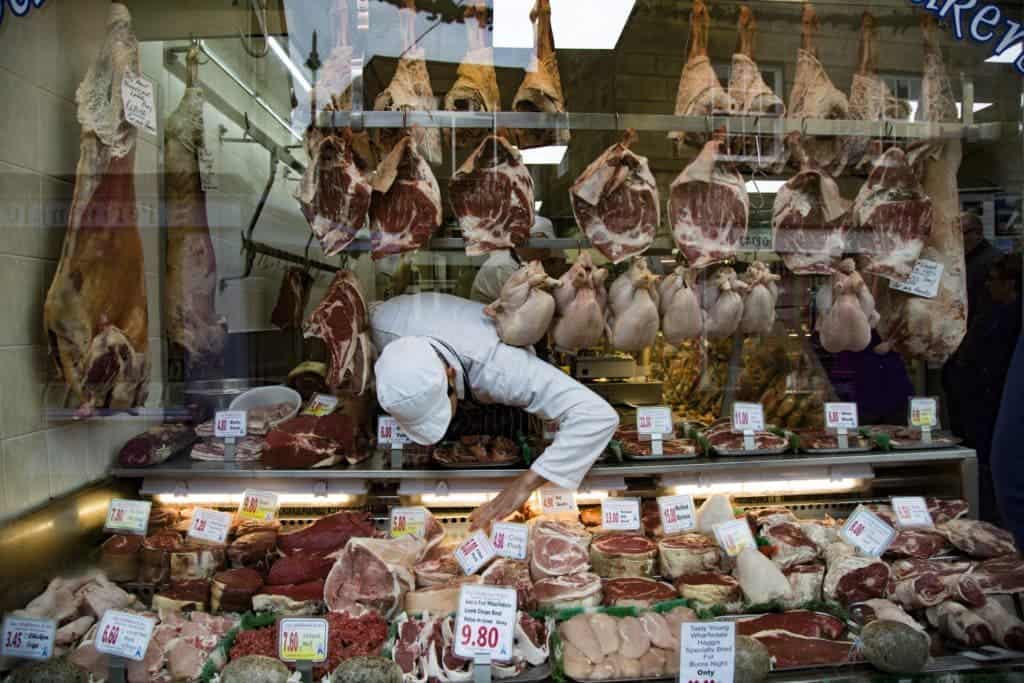Our food choices help shape the environment around us. A new study looks at how livestock, farmed seafood, and wild-caught fish compare in the environmental impact department — so we know exactly what our choices of animal protein entail.

The study’s authors call it the most comprehensive look at the effect different types of animal protein production have on the environment. While the rating depends on exactly which criteria you’re looking at, in general, industrial beef production and farmed catfish are the most taxing on the environment, while small, wild-caught fish and farmed mollusks like oysters, mussels and scallops have the lowest environmental impact, they report.
What to eat
“From the consumer’s standpoint, choice matters,” says lead author Ray Hilborn, a professor in the School of Aquatic and Fishery Sciences at the University of Washington.
“If you’re an environmentalist, what you eat makes a difference. We found there are obvious good choices, and really obvious bad choices.”
The team drew their data from previously-published life-cycle assessments for various types of animal protein production. The dataset included hundreds of papers penned throughout the last decade. This type of assessment is also known as a ‘cradle-to-grave’ analysis, as it accounts for a product’s environmental impact during every stage of its life. The team started with over 300 papers assessing animal-associated food production, which they whittled down to 148 studies that were comprehensive enough for the team’s purpose without being focused on a too-narrow subject.
Each type of animal food production was broadly analyzed through the prism of four metrics: energy use, greenhouse gas emissions, potential to contribute excess nutrients to the environment (such as fertilizers), and each’s potential to emit substances that contribute to acid rain. The present analysis also included other environmental impacts such as water demand, pesticide use, antibiotic use, and soil erosion. However, as they were only addressed in some of the studies the team drew on, the team didn’t use them as overarching points of comparison.
Production methods analyzed include aquaculture (farmed seafood), livestock farming, and wild-capture seafood. To make the environmental impacts easily relatable, they were calculated for the daily recommended serving of protein, 40 grams (1.4 oz), across all food types, where data permitted.
Meat me halfway
All in all, the paper found some stark differences in the impacts associated with different types of animal protein. Certain production methods are just better from an ecological standpoint — across all measures. Farmed shellfish and mollusks, as well as wild-capture sardines, mackerel, and herring show some of the lowest ecological footprints. Wild-capture whitefish like pollock, hake, or cod, also had relatively low environmental impacts, as did farmed salmon.
Livestock farming scored strongly for energy use, even better than most types of aquaculture. For example, catfish, shrimp, and tilapia aquaculture consume a lot of energy, since they require constant water circulation — which means constant energy use.
Mollusk (oysters, mussels, or scallops, for example) aquaculture scored high on nutrient leaks — these animals actually absorb excess nutrients in the ecosystems, helping to insulate them from fertilizer pollution, for example. Beef production, on the other hand, rated very poorly here, since the waste winds up in waterways. Capture fisheries scored better here than aquaculture or livestock — it doesn’t require any fertilizer.
Livestock farming scored poorly in the acid rain category because of methane emissions associated with their rearing. Catfish aquaculture and beef production release 20 times more greenhouse gases than small capture fisheries, mollusk, salmon or chicken farming. Farmed mollusks rated the highest here, followed by small capture fisheries and salmon aquaculture. Capture fisheries fell behind in the emissions department due to the high fuel consumption associated with sending vessels out to sea. Small schooling fish like herring and anchovy uses the least fuel, but pot fisheries for lobster use lot of fuel and thus have a high impact per unit of protein produced. Trawling (dragging nets through water) has a variable impact, mostly dependent on the availability of fish stocks.
Quite surprisingly, the paper finds that a selective diet of aquaculture and wild-capture fish has a lower overall environmental impact than vegetarian or vegan diets (as calculated in previous studies). One metric the team didn’t include in their study is how each production method impacts biodiversity — but they plan to factor it in in the future.
“I think this is one of the most important things I’ve ever done,” Hilborn said. “Policymakers need to be able to say, ‘There are certain food production types we need to encourage, and others we should discourage.'”
The researchers advise that consumers decide what environmental impacts are most important to them, then use the results to select what they put on the plate.
The paper “Choice matters: The environmental costs of producing meat, seafood” has been published in the journal Frontiers in Ecology and the Environment.






